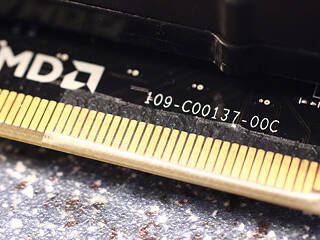 73
73
AMD Radeon HD 5870 PCI-Express Scaling Review
Test Setup »Introduction
September 2009 is a big month for both AMD and Intel in nearly equal measures. While Intel introduced its brand new socket LGA-1156 family of processors and the Intel P55 chipset to drive its platform, AMD launched the industry's first DirectX 11 compliant lineup of graphics processors, particularly the Radeon HD 5870 (our review here), which is powered by the fastest graphics processor currently available. To ensure that the graphics card is working to its full-potential, one of the important factors is the system interface, and the system's ability to provide as much bandwidth as it can to the GPU. One of the characteristic features of Intel's socket LGA-1156 processors is the on-die PCI-Express 2.0 switch that can provide a PCI-Express 2.0 x16 link for graphics.
Thanks to the modular, scalable design of PCI-Express, consisting of independent data-paths called 'lanes', motherboard designers can control a limited PCI-Express lane budget, and offer multiple PCI-Express x16 slots. In mid-range motherboards, and particularly in most motherboards based on Intel's newest P55 chipset, 16 PCI-Express lanes are used to drive two PCI-Express slots with bandwidths of 8 lanes each. These two slots can then accommodate two graphics cards for multi-GPU performance upscaling using ATI CrossfireX or NVIDIA SLI technologies. It should also be noted that PCI-Express 2.0 doubles the bandwidth available per lane. So if you read about PCI-E x8 2.0 in this review, these results are representative of a PCI-E x16 link in 1.1 mode - like on many old motherboard. Another important point to make is that PCI-Express is forward and backwards compatible. You can run any PCI-E 1.x card in a 2.0 slot or any 2.0 card in any 1.x slot, with reduced bandwidth of course.
In this review, we test the impact of running the ATI Radeon HD 5870 graphics accelerator on PCI-Express slots that are electrically PCI-Express 2.0 x8, x4, and x1. This is done by covering the data-paths using thin, insulating adhesive tape, which turns off those data-paths (lanes), while still keeping the device functional. Tests at PCI-Express 2.0 x8 will show you how the Radeon HD 5870 with its seemingly heavy system bandwidth requirement fares on systems with PCI-Express 2.0 x16 electrical x8 slots. Tests at PCI-Express 2.0 x4 will give you a rough idea of how it fares on systems with PCI-Express x16 electrical x4 (there are plenty of such motherboards), and also systems with PCI-Express 1.1 x16 electrical 1.1 x8. Finally, we dared to run this monstrosity on just one PCI-Express 2.0 lane. Not only was it functional, but also stable, returning results on all the tests we threw at it. While not serving any practical purpose, tests on PCI-Express x1 are merely of academic relevance.
Apr 24th, 2024 06:27 EDT
change timezone
Latest GPU Drivers
New Forum Posts
- EK seems to be having major issues (30)
- Windows 11 General Discussion (5023)
- The TPU UK Clubhouse (24777)
- What's your latest tech purchase? (20331)
- My computer setup - Request for opinions (13)
- Share your AIDA 64 cache and memory benchmark here (2914)
- CYBERPUNK 2077 O.F. (5)
- What phone you use as your daily driver? And, a discussion of them. (1458)
- Which new games will you be buying? (309)
- Official Board Game Discussion (15)
Popular Reviews
- Fractal Design Terra Review
- Corsair 2000D Airflow Review
- Thermalright Phantom Spirit 120 EVO Review
- Minisforum EliteMini UM780 XTX (AMD Ryzen 7 7840HS) Review
- ASUS GeForce RTX 4090 STRIX OC Review
- NVIDIA GeForce RTX 4090 Founders Edition Review - Impressive Performance
- ASUS GeForce RTX 4090 Matrix Platinum Review - The RTX 4090 Ti
- MSI GeForce RTX 4090 Suprim X Review
- MSI GeForce RTX 4090 Gaming X Trio Review
- Gigabyte GeForce RTX 4090 Gaming OC Review
Controversial News Posts
- Sony PlayStation 5 Pro Specifications Confirmed, Console Arrives Before Holidays (116)
- NVIDIA Points Intel Raptor Lake CPU Users to Get Help from Intel Amid System Instability Issues (106)
- AMD "Strix Halo" Zen 5 Mobile Processor Pictured: Chiplet-based, Uses 256-bit LPDDR5X (101)
- US Government Wants Nuclear Plants to Offload AI Data Center Expansion (98)
- Windows 10 Security Updates to Cost $61 After 2025, $427 by 2028 (84)
- Developers of Outpost Infinity Siege Recommend Underclocking i9-13900K and i9-14900K for Stability on Machines with RTX 4090 (84)
- TechPowerUp Hiring: Reviewers Wanted for Motherboards, Laptops, Gaming Handhelds and Prebuilt Desktops (77)
- Intel Realizes the Only Way to Save x86 is to Democratize it, Reopens x86 IP Licensing (70)

